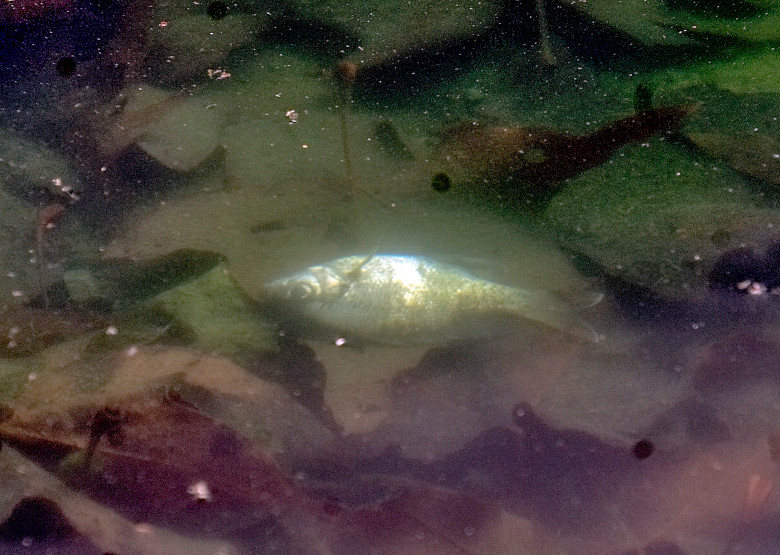
30 Jun Is Algae in Your Pond Causing a Big Problem?
Learn how to eliminate pond algae
Have an Overgrowth of Pond Algae? Learn How to Naturally Fight Algae.
Why is there algae in my pond?
What is algae? Most simply, algae is a living organism, that at some levels and in some forms is an important part of the ecosystem of any body of water. Similar to, but not officially, a plant, algae contains chlorophyll, photosynthesizes, and outputs much of the Earth’s oxygen supply. Algae consumes nutrients that are added naturally to water by fish waste and other organic material, like decaying plants.
Algae doesn’t have a defined root system, rather, it floats on the surface of the water. It thrives with sunlight and nutrients, especially phosphorous and nitrogen. If you are a science geek, you might enjoy learning more about its evolution and DNA here.
Algae in a pond or lake is an important part of filtering water and the aquatic ecosystem, but often a combination of factors can contribute to its overgrowth, and in the case of algae, more is not better. Algae causes common problems with waterways, lakes, and ponds as it feeds off of excess nutrients.
When algae eats more, you will end up with more algae in your pond. It can make your pond green. It can also make your pond stink. It can cause a fish kill. Algae can be dangerous for your dog.

Is algae the reason my pond stinks? Is algae why my pond is green?
The overgrowth of algae can severely reduce the oxygen content of the water, shades the rooted beneficial plants that provide food for the fish, and interferes with the natural surface area circulation that occurs in a healthy pond ecosystem.
When algae undergoes a population explosion, it results in an algae bloom. This may be known as a harmful algae bloom or an HAB. Often, the cause of an HAB is agricultural run-off containing fertilizers that stimulate increased growth. Many bodies of water associated with agriculture, storm water management, or septic systems, as well as lawn and garden fertilizers carry an unnaturally high nutrient load and are susceptible to harmful algae blooms.
A pond that is covered in algae is that way because it has too many nutrients. Excessive nutrients and algae growth in a pond will lead to excessive organic matter decomposing on the bottom of the pond. The decomposition lowers oxygen levels and leads to foul pond odors. Nearly all major pond problems can be traced back to this cause.
When water is overburdened by nutrients, mainly nitrogen and phosphorus, a process called eutrophication occurs. Eutrophication affects municipal waterways and recreational ponds as well as private landscape gardens and is considered a planet-wide environmental problem. Studies have shown that eutrophication affects 48% of North American waterways.
Eutrophication is harmful to other aquatic life forms, animals—like pet dogs, and even humans. Added to this is the fact that an algae bloom is usually offensive—It makes your pond smell bad and your pond water green and cloudy.
If you’re in California, you can learn more about the danger of harmful algae blooms at their water quality website, here. Outside of California, your state might have info at its “dot gov” site too. It’s a big deal.
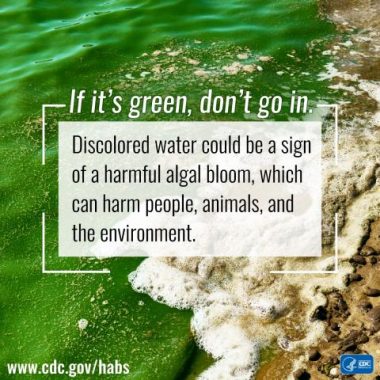
How do I get rid of algae, create clear pond water, and restore water quality?
There are many different available methods of algae control, and they vary in convenience, applicability to your situation, availability, financial cost, and long term environmental impact.
You’ll find that readily available chemical solutions for algae control such as herbicides, or algaecides, are often copper based. Copper stays in the water and will continue to harm even beneficial bacteria and microbes for many years to come, preventing the restoration of a naturally healthy ecosystem. If you look at how to use algae control, you’ll see it’s not a one-time application. They are expensive. Algae oil and algae eaters kill the algae and then their rapid decay can contaminate water with high concentrations of algal toxins which is dangerous for fish and plants. Algaecides can have significant long-term effects on the lake’s ecological balance.
Nutrient binders, like Phoslock, essentially grab the phosphorous being released by lake sediments, and holds it at the bottom of the pond, where it stays locked in. If most of the phosphorous is taken up in the algae bloom, Phoslock cannot bind it. And when new sources come in, they must travel down to the sediment before the Phoslock holds it. Re-application is often necessary.
Can I get rid of pond algae without chemicals?
Mechanical solutions include dredging, an expensive and inconvenient process of physically removing the organic muck at the bottom of the pond—you need access; raking can work well if your problem is string or filamentous algae, but it does nothing for the smaller planktonic algae that make your pond water green.
You might have heard about using barley straw for algae control, but adding barley straw to a pond which is already struggling with high waste problems would only amplify the issues, causing drops in oxygen and a rise in harmful substances.
Aeration is a common and environmentally friendly technique, often seen in municipal ponds and lakes. Aeration improves algae issues, unfortunately, fountains were developed more for visual effect, and the benefits they bring to ponds are minimal. While fountains increase the level of oxygen in the water, which is necessary to create a healthy ecosystem, it only adds minimal oxygen, just where the water droplets hit the water, and only pushes usable oxygen down to 18” deep. Adding lateral circulation increases this depth, but fountains and circulators often require maintenance and labor and they always use a lot of energy.
There is even a technology that uses ultrasound to treat algae, and if you have a filtering system, it’s possible to add UV light treatment. Both of these things kill both bad and good bacteria.
Are there green solutions or natural solutions to eutrophication? Any solutions without unwanted side effects?
Because both algae and plants use the same nutrients, adding plants to a pond will reduce what is available for algae. Not only do plants remove excess nutrients from the pond, but they also release oxygen during photosynthesis. Look for plants that won’t create a new problem for you. Aquatic plants are like nature’s water filter, but not all plants are the same. The root structure of plants, which are also important for holding microbes and gas bubbles, do most of the work.
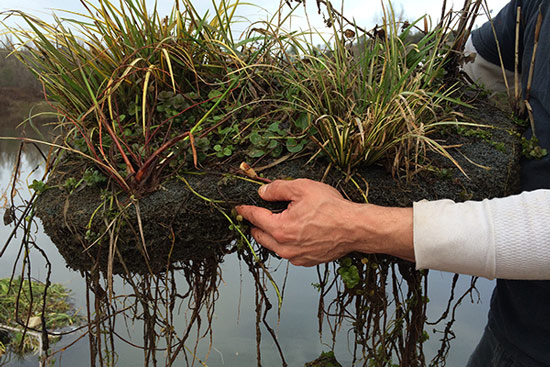
Adding shade to a pond protects it from excess sunlight to reduce the likelihood of algae blooms. The biggest benefit of shade is not that it prevents sun from reaching the water—because beneficial pond weeds need some sunlight (for photosynthesis, see above), but that shade allows for a decrease in water temperature. Algae loves the heat.
In nature, microbes also eat these same excess nutrients that algae love. By creating more microbes, you will eventually starve the algae of its main food source. Microbes in the form of biofilm are the biggest factors in removing nutrients from the water. Biofilm is what some of us would look at as the nasty slimy stuff that covers a stick that has been in the water, that makes river rocks slippery, and catches in the roots of all the plants that grow in the water. Any place that there is a matrix of material, like in a floating wetland, an abundance of microbes thrive.
What is the best solution to my algae problem?
Given the evidence above, we believe that the most ecologically sound solution to poor pond water quality, smelly pond water, harmful algae blooms that result in green water and eutrophication is to encourage the growth of microbes and the creation of biofilm. This, in conjunction with adding shade, and beneficial plants with roots that reach down into the water to introduce and trap usable oxygen, will provide the best solution to your algae problem.
How do I increase the microbes and create biofilm in my pond?
When the environmental conditions in your pond are right, you won’t have a problem with an overgrowth of algae, bad smells and green water. So it makes the most sense to create a water quality solution that restores a healthy habitat in your lake or pond.
Habitat restoration means building a place where biofilm can grow. Think of floating natural wetlands, and look there for the solution. With augmented surface area and circulation, shade, plant and deep root growth, and living organisms, you can get rid of pond algae without chemicals.
When you encourage the growth of microbes, the creation of biofilm and periphyton, providing a food source for fish, (fishing being a primary method for transitioning excess nutrients from the water) you are restoring the natural ecosystem of your pond.
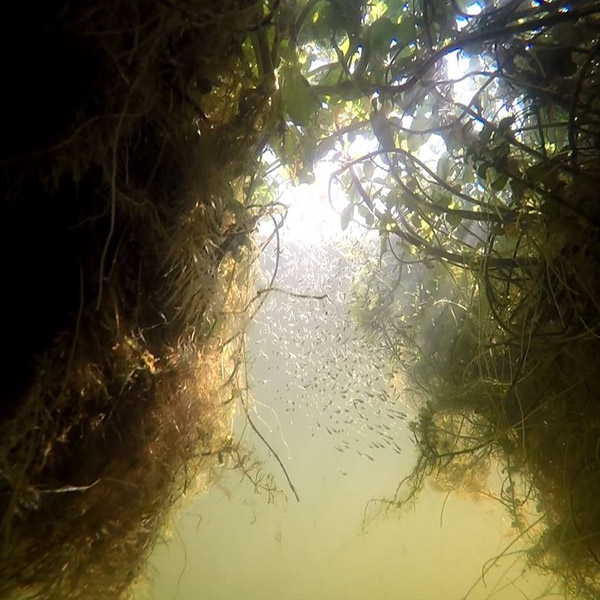
How does a floating island work to clean pond water?
BioHaven Floating Islands represent a holistic way to remove the problem-causing nutrients from your waterway and convert them into a beautiful and wildlife enhancing floating island habitat. The secret is within our proprietary design—our BioHaven island matrix—this creates more microbes, and more microbes equals cleaner and healthier water.
Implementing a BioHaven floating island into your dirty pond will help with the overall quality and water clarity. While it will not completely eliminate algae, your floating island will help prevent algae from developing into a monoculture in your waterway.
BioHaven floating islands create microbes. The microbes feed off of the same food source that algae feeds off of—Biohaven floating islands are like a housing unit for microbes and the more microbes in your pond, the more food they will eat—meaning that algae will eventually begin to starve.
BioHaven floating islands attract and bond suspended solids and colloidal into the island matrix where they will ultimately become soil and plants and beneficial microbes and gas. Some of these solids will also be sequestered into other life forms like damsel fly nymphs and fish.
The plants and especially the microbes that occur on a floating island will seriously compete for nutrients with all of the other biota in your pond. Floating islands provide additional competition for nutrients will help with overall water quality.
In addition to competition for food, when the roots of the island plants extend downward, they keep usable oxygen in the water, carrying it up to four feet deep, where substantial water life lives.
A floating island also decreases the water temperature in its shade by almost three degrees, which is significant for all life that is susceptible to extreme heat, and provides the benefit of shade around its entire circumference. The island becomes a refuge—a safe haven where life can live around it.
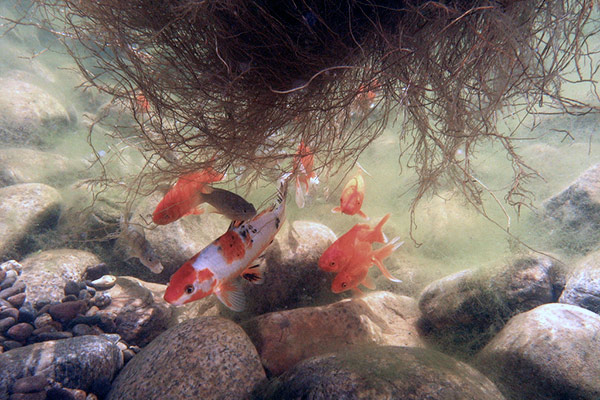
Over time the pond will develop a new balance and the problem of HABs, smelly pond water, and dangerous green water, will be a thing of the past.
Is there evidence that this really works?
At Research Lake near Shepherd, Montana USA, Floating Treatment Wetlands were used to Mitigate Lake Eutrophication. Enhanced Circulation and Nutrient Uptake were used as simple, cost effective water treatment strategies that transformed agricultural effluent into world-class fish habitat.
The Barrington, Illinois Lake County Stormwater Management Commission named the BioHaven® FTWs Remove Algae & Create Wildlife Habitat project the “Best Management Practice (BMP) Project of the Year.”
BioHaven® Floating Treatment Wetlands (Floating Islands) have been successfully deployed in many diverse waterways, including wastewater treatment, storm water management, freshwater and marine environments; public, private, domestic, as well as international.
More evidence can be found in this extensive list of studies and testimonials.

Sorry, the comment form is closed at this time.